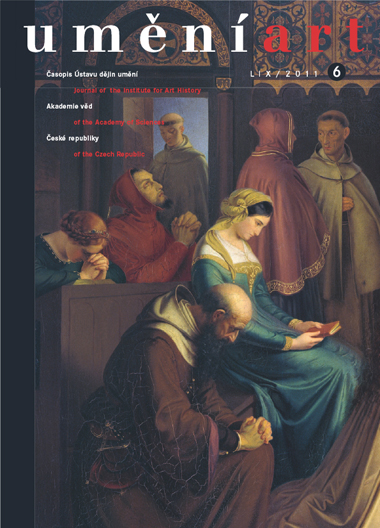Jan Řezáč
Inventio et/versus imitatio. Alegorie umělecké/umělcovy inspirace - Overbeckova Italie a Germanie na pozadí raně romantické filosofie
The author examines the themes of imitation, inspiration, and the model in Nazarene painting and describes the context of Josef Mánes's painting Petrarch Meeting Laura (1846). He shows how the Neo-Platonic idea of creation as imitation or mimesis transformed during the first third of the 19th century into a relationship between the artist and the artist's inspiration, personified as the muse, from the realm of ideas. A forerunner to these Romantic ideas can be found in the Enlightenment discussion of questions of taste. As the author's interpretation of the print Expertise in Art by Daniel Chodowiecki shows, the opposing scenes of a townsman and an aristocratic consumer of art do not represent an expert but the artist himself. Chodowiecki drew on another component of the early Romantic interpretation of artistic creation: the sacralisation of art and artistic inspiration. Chodowiecki's Tolerance (1791) presents the statue of Pallas Athena bestowing a 'halo of Enlightenment' on theologians, religious thinkers, and mystics. Angelica Kauffmann contributed her depiction of sacred inspiration with the theme of paragone and the identification of the artist with the model in her Self-portrait between Allegories of Music and Painting (1791-1792), where she depicts herself in conversation with two muses. The Nazarene painters drew on the 16th-century theorists Lodovico Dolce and Karlo van Mandero and united painting and poetry in one. This complex development culminated in Overbeck's painting Italy and Germany (1815-1828), compositionally based on an allegory of the creation of art, understood as the unity of two opposites, poetry and painting (ut pictura poesis), and an artistic friendship. Overbeck's intention, thus far interpreted in connection with the story of Sulamith and Marie and in reference to the personal psychology of the artist, represents according to the author a self-representational attempt to reconcile the contradictory and often independent components of the work of painting - imitatio and inventio.
Full-text in the Digital Library of the Czech Academy of Sciences:
https://kramerius.lib.cas.cz/uuid/uuid:620bb1cc-fde6-254a-98ad-ffe76933e28d
< back

